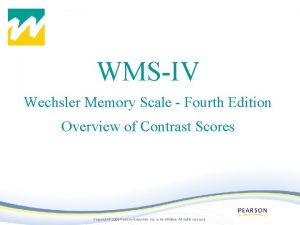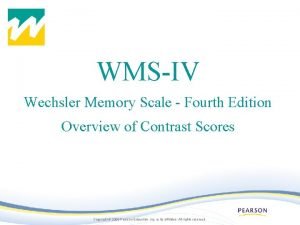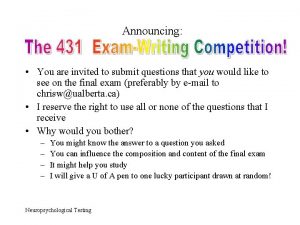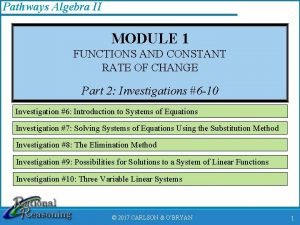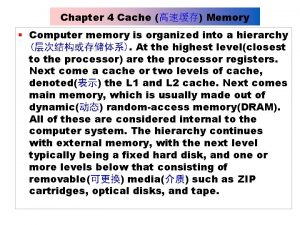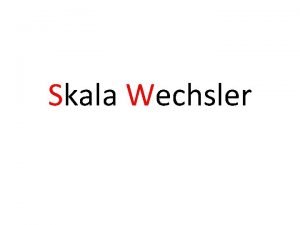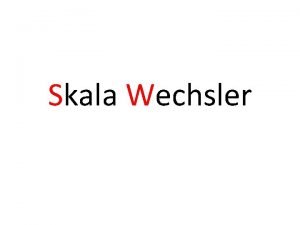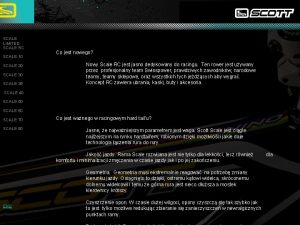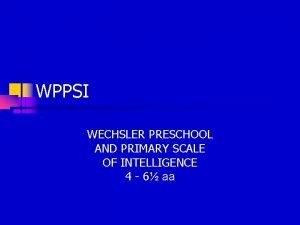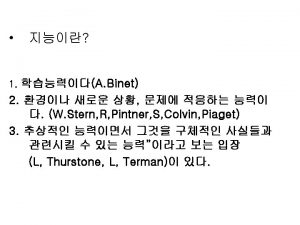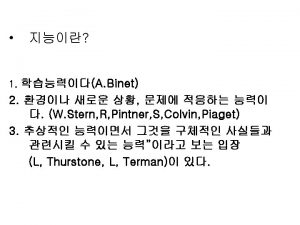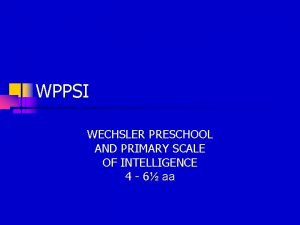WMSIV Wechsler Memory Scale Fourth Edition Overview of





















- Slides: 21

WMS-IV Wechsler Memory Scale - Fourth Edition Overview of Contrast Scores Copyright © 2008 Pearson Education, inc. or its affiliates. All rights reserved.

Agenda • Overview of Standard Scores • Review of Traditional Discrepancy Analyses • Contrast Score Methodology • Using Contrast Score Tables • Contrast Score Interpretation – Case Examples Copyright © 2008 Pearson Education, inc. or its affiliates. All rights reserved.

Standard Scores • Norm Scores – Individual scores are compared to a normative group and establish a person’s ability in relation to others – Norm scores are used to compare an individual to same age peers – Interpretation is straightforward, performance is interpreted in relation to norm group – Typically, adjustments are only made for age – Performance is impaired in relation to same age peers Copyright © 2008 Pearson Education, inc. or its affiliates. All rights reserved.

Discrepancy Analyses • Used to determine whether scores are different from one another • Assist in profile analysis • Provides means of interpreting score differences Copyright © 2008 Pearson Education, inc. or its affiliates. All rights reserved.

Simple-Difference Discrepancy Analyses • Used in WISC-IV, WAIS-IV and WMS-IV • Obtain a difference by subtracting Score A from Score B • Compare the obtained difference using critical values and base rates – A critical value is the minimum required value of a difference in order to obtain statistical significance – The same critical values are used across ability levels Copyright © 2008 Pearson Education, inc. or its affiliates. All rights reserved.

Simple-Difference Discrepancy Analyses – Base rates are used to determine if a statistically significant difference is rare and potentially clinically significant – Base rates are the frequency with which a specific difference occurred in the normative sample – Base rates are presented as percentages of the overall sample or by ability level bands – The less frequent the difference in the normative sample, the more clinically relevant it is assumed to be Copyright © 2008 Pearson Education, inc. or its affiliates. All rights reserved.

Predicted Difference Discrepancy Analyses • Used for WAIS-IV/WMS-IV Comparisons • Uses regression methodology to create predicted scores • Difference between predicted and actual scores are compared with critical values and base rates • Typically use linear regression techniques that assume a constant rate of change across ability levels • Typically tails of the distribution produce greater variability in scores so linear techniques underestimate differences at the tails and overestimate differences at the middle range of ability Copyright © 2008 Pearson Education, inc. or its affiliates. All rights reserved.

Interpretation of Discrepancy Analyses • Difference between 2 scores is equal to or greater than critical value (statistically significant) – Johnny’s Working Memory Index and Verbal Comprehension Index are statistically different at the. 05 level • Base rates for the difference is 10. 4 % in the overall sample and 8. 9% by ability level – The difference occurs in 10. 4% of the standardization sample. – The difference occurs in 8. 9% of the standardization sample at Johnny’s ability level. Copyright © 2008 Pearson Education, inc. or its affiliates. All rights reserved.

Contrast Score Overview • Introduced by James A. Holdnack (2007) • Included within NEPSY-II, WMS-IV, and ACS (Advanced Clinical Solutions for WAIS-IV and WMS-IV will publish in Fall 2009) • Contrast scores adjust scores in similar manner as demographically adjusted scores – Adjust one score based on performance on a previous or more basic task • • Delayed Memory adjusted for Immediate Memory Recall Memory adjusted for Recognition Recall Memory adjusted for Repetition Inhibition adjusted for Naming Fluency Copyright © 2008 Pearson Education, inc. or its affiliates. All rights reserved.

Contrast Score Overview • Contrast scores yield new normative information on a dependent measure, adjusting for the ability on the control variable – Contrast score name reflects which variable is control and which is dependent – Control variable is listed first in the score title and is used in regression to create the contrast score – Dependent measure is listed second in the title and the derived contrast score reflects performance on this measure • Examples – Control vs. Dependent Contrast Scaled Score – Auditory Attention vs. Response Set Contrast Scaled score – Logical Memory Immediate Recall vs. Delayed Recall Copyright © 2008 Pearson Education, inc. or its affiliates. All rights reserved.

Contrast Score Overview • Scored on 1 -19 Scaled Score Metric • Does not replace normative scores • Answer’s specific hypothesis about an examinee’s performance relative to their performance on other measures • Norm score asks: Is this person’s delayed memory impaired? • Contrast score asks: Is this person’s delayed memory impaired given their initial encoding ability? Copyright © 2008 Pearson Education, inc. or its affiliates. All rights reserved.

Using Contrast Score Tables Copyright © 2008 Pearson Education, inc. or its affiliates. All rights reserved.

Contrast Score Interpretation • Higher scores indicate better than expected performance on the dependent score given performance on the control score – Delayed Memory is better than expected given the examinee’s level of ability on immediate memory – Delayed Memory is superior when compared to individuals of similar encoding ability Copyright © 2008 Pearson Education, inc. or its affiliates. All rights reserved.

Contrast Score Interpretation • Low scores indicate poorer than expected performance on the dependent score given performance on the control score – Delayed Memory is impaired given the examinee’s level of ability on immediate memory – Delayed Memory is impaired when compared to individuals of similar encoding ability Copyright © 2008 Pearson Education, inc. or its affiliates. All rights reserved.

Contrast Score Interpretation • Scores in the average range (8 -12) indicate no difference in performance between the control and dependent measures – Performance on delayed memory is not significantly different from ability on immediate memory – Delayed Memory performance is similar to encoding ability Copyright © 2008 Pearson Education, inc. or its affiliates. All rights reserved.

• Example 1 Contrast Scores Case Examples – Normative Scores • Joe obtains a 6 on VR I and a 6 on VR II • Interpret VR I and VR II as impaired in comparison to his same age peers – Simple Difference Discrepancy Analysis • VR I (6) – VR II (6) = 0 • Difference is not statistically significant – Final Interpretation Using Simple Difference • Both VR I and VR II are impaired but are not significantly different from one another – Suggested Intervention • Target interventions toward both encoding and retrieval deficits Copyright © 2008 Pearson Education, inc. or its affiliates. All rights reserved.

Contrast Scores Case Examples – Normative Scores • Joe obtains a 6 on VR I and a 6 on VR II – Contrast Score • VR I vs. VR II Contrast Scaled Score is 8 – Final Interpretation Using Contrast Scaled Score • In relation to his peers, both immediate and delayed memory are impaired. Contrast score shows that VR Delayed is actually within average (SS=8) when adjusted for his immediate ability. His delayed memory performance is being impacted by his immediate memory ability. Thus, his critical memory problem may be in initial encoding ability. – Suggested Intervention • Target intervention toward encoding difficulties Copyright © 2008 Pearson Education, inc. or its affiliates. All rights reserved.

• Example 2 Contrast Scores Case Examples – Normative Scores • Joe gets all items correct on recognition (>75%) and obtains an 8 on LM II Delayed Recall • Interpret Recognition as above average and LM II as average in comparison to same age peers – Simple Difference Discrepancy • Can’t complete as both scores are not on same metric – Final Interpretation Using Simple Difference • Compared to same age-peers, recognition performance is above average and delayed recall performance is average – Suggested Intervention • No intervention is needed Copyright © 2008 Pearson Education, inc. or its affiliates. All rights reserved.

Contrast Scores Case Examples – Normative Scores • Joe gets all items correct on recognition (>75%) and obtains an 8 on LM II Delayed Recall – Contrast Score • LM Recognition vs. LM II Contrast Scaled Score is 6 – Final Interpretation Using Contrast Scaled Score • Compared to same age-peers, recognition performance is above average and delayed recall performance is average. Contrast Score demonstrates that recall is unexpectedly low for his recognition ability. His performance appears to be impacted by his retrieval ability. Thus, his critical memory problem may be in memory retrieval or expressive language ability. – Suggested Intervention • Assess expressive language, target intervention toward retrieval difficulties Copyright © 2008 Pearson Education, inc. or its affiliates. All rights reserved.

Contrast Scores Case Examples • Example 3 (General Ability vs. Delayed Memory) – Normative Scores • Joe obtains GAI of 120 and DMI of 100 • Interpret GAI of 120 as superior and DMI of 100 as average – Simple Discrepancy Analysis • GAI (120) – DMI (100) = 20 • Difference is statistically significant; base rate of 5 -10% – Final Interpretation Using Simple Difference • DMI is significantly lower than GAI and a difference this large occurs in less than 10% of the standardization sample. Both skills are average compared to same age peers but delayed memory is relatively weak in comparison to general cognitive ability – Suggested Intervention • If any intervention is needed, focus on delayed memory abilities Copyright © 2008 Pearson Education, inc. or its affiliates. All rights reserved.

Contrast Scores Case Examples – Normative Scores • Joe obtains GAI of 120 and VMI of 100 – Contrast Score • GAI vs. DMI Contrast Scaled Score is 7 – Final Interpretation Using Contrast Scaled Score • Contrast Score shows that his DMI score is low average given his general cognitive ability. – Suggested Intervention • Target intervention on delayed memory abilities Copyright © 2008 Pearson Education, inc. or its affiliates. All rights reserved.
 Wmsiv
Wmsiv Wechsler memory scale score interpretation
Wechsler memory scale score interpretation Wechsler memory scale scoring
Wechsler memory scale scoring Wechsler individual achievement test second edition
Wechsler individual achievement test second edition Language
Language Project 2 fourth edition
Project 2 fourth edition Pathways algebra 2
Pathways algebra 2 Ethics in information technology fourth edition
Ethics in information technology fourth edition Ethics in information technology fourth edition
Ethics in information technology fourth edition Vertical line code in html
Vertical line code in html Discrete math susanna epp
Discrete math susanna epp Expert systems: principles and programming, fourth edition
Expert systems: principles and programming, fourth edition Set associative mapping in cache memory
Set associative mapping in cache memory Computer memory system overview
Computer memory system overview Using mis (10th edition) 10th edition
Using mis (10th edition) 10th edition Report
Report Semantic memory example
Semantic memory example Explicit memory
Explicit memory Long term memory vs short term memory
Long term memory vs short term memory Internal memory and external memory
Internal memory and external memory Primary memory and secondary memory
Primary memory and secondary memory Logical memory vs physical memory
Logical memory vs physical memory
